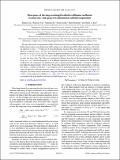Divergence of the long-wavelength collective diffusion coefficient in quasi-one- and quasi-two-dimensional colloidal suspensions
Author(s)
Lin, Binhua; Cui, Bianxiao; Xu, Xinliang; Zangi, Ronen; Diamant, Haim; Rice, Stuart A.; ... Show more Show less
DownloadLin-2014-Divergence of the long-wavelength.pdf (967.5Kb)
PUBLISHER_POLICY
Publisher Policy
Article is made available in accordance with the publisher's policy and may be subject to US copyright law. Please refer to the publisher's site for terms of use.
Terms of use
Metadata
Show full item recordAbstract
We report the results of experimental studies of the short-time–long-wavelength behavior of collective particle displacements in quasi-one-dimensional (q1D) and quasi-two-dimensional (q2D) colloid suspensions. Our results are reported via the q → 0 behavior of the hydrodynamic function H(q) that relates the effective collective diffusion coefficient D[subscript e](q), with the static structure factor S(q) and the self-diffusion coefficient of isolated particles D[subscript 0]: H(q) ≡ D[subscript e](q)S(q)/D[subscript 0]. We find an apparent divergence of H(q) as q → 0 with the form H(q)∝q[superscript −γ] (1.7 < γ < 1.9) for both q1D and q2D colloid suspensions. Given that S(q) does not diverge as q → 0 we infer that D[subscript e](q) does. This behavior is qualitatively different from that of the three-dimensional H(q) and D[subscript e](q) as q → 0, and the divergence is of a different functional form from that predicted for the diffusion coefficient in one-component one-dimensional and two-dimensional fluids not subject to boundary conditions that define the dimensionality of the system. We provide support for the contention that the boundary conditions that define a confined system play a very important role in determining the long-wavelength behavior of the collective diffusion coefficient from two sources: (i) the results of simulations of H(q) and D[subscript e](q) in quasi-1D and quasi-2D systems and (ii) verification, using data from the work of Lin, Rice and Weitz [Phys. Rev. E 51, 423 (1995)], of the prediction by Bleibel et al., arXiv:1305.3715, that D[subscript e](q) for a monolayer of colloid particles constrained to lie in the interface between two fluids diverges as q[superscript −1] as q → 0.
Date issued
2014-02Department
Massachusetts Institute of Technology. Department of ChemistryJournal
Physical Review E
Publisher
American Physical Society
Citation
Lin, Binhua, Bianxiao Cui, Xinliang Xu, Ronen Zangi, Haim Diamant, and Stuart A. Rice. “Divergence of the Long-Wavelength Collective Diffusion Coefficient in Quasi-One- and Quasi-Two-Dimensional Colloidal Suspensions.” Phys. Rev. E 89, no. 2 (February 2014). © 2014 American Physical Society
Version: Final published version
ISSN
1539-3755
1550-2376